
Bajadasaurus
Meet the spiny-necked Cretaceous giant!
Period
Cretaceous
Length
Approximately 40 feet long.
Height
Roughly 13 feet at the shoulder.
Weight
Around 4 tons, similar to other sauropods.
Bajadasaurus was a long-necked dinosaur that roamed the earth during the Early Cretaceous period. It's best known for its incredible spiny neck, which likely served to deter predators. These herbivorous giants traveled in herds, roaming the ancient landscapes of what is now South America. Bajadasaurus represents a fascinating branch of the sauropod family, providing insight into the wide diversity and adaptative strategies of these prehistoric giants.
Diet
Bajadasaurus was herbivorous, feeding on a variety of plants. Their long necks allowed them to reach vegetation high up in trees and shrubs, as well as low-lying plants.
Hunting
As a plant-eater, Bajadasaurus did not hunt for prey. Instead, it foraged for food across its habitat, needing to consume large amounts of vegetation to sustain its massive size.
Environmental challenges
Bajadasaurus faced environmental challenges such as fluctuating climates and changing landscapes during the Cretaceous period. Predation was another challenge, likely from large theropods. The spines along its neck might have been an adaptation to protect against these predators.
Speed
Likely slow due to its massive size.
Lifespan
Lived for several decades, like other large dinosaurs.
First discovery
Discovered in Argentina in 2010.
Fun Facts
- Bajadasaurus was a dinosaur with incredibly long, curved spines on its neck that might have helped protect it from predators.
- This dinosaur lived around 140 million years ago during the early Cretaceous period.
- The name 'Bajadasaurus' means 'lizard from Bajada', named after the region in Argentina where its fossils were found.
- Bajadasaurus belonged to a group of dinosaurs called sauropods, known for their large size and long necks.
- Scientists believe these spines could have been covered with skin, making them look like horns or sails.
- Despite its fierce appearance, Bajadasaurus was a herbivore, meaning it lived on a diet of plants.
- The discovery of Bajadasaurus helps scientists understand more about the diversity and evolution of dinosaurs in South America.
Growth and Development
Bajadasaurus likely hatched from eggs, growing rapidly in its early years to eventually reach its large adult size. Like other sauropods, growth may have been aided by a high metabolism and efficient digestive system. Continuous growth throughout its life may have been a strategy to maintain dominance.
Habitat
The Bajadasaurus inhabited the lush floodplains and forests of what is now modern-day Argentina. These environments provided ample vegetation for their herbivorous diet. The region's rivers and lakes were ideal for the sustenance of herds, ensuring both food and water supply.
Interaction with other species
Bajadasaurus possibly coexisted with various other dinosaurs and prehistoric creatures. Its spiny neck might have been used for defense against predators. It's likely that they lived in herds, using numbers as a strategy for protection against carnivorous threats.
Natural lifespan
Bajadasaurus likely lived up to 70-80 years.
Reproduction
Reproduction in Bajadasaurus involved laying eggs. Like other sauropods, they likely nested in colonies, with females laying clutches of eggs in sandy or muddy areas to incubate under the sun. Hatchlings were much smaller versions of adults, requiring rapid growth for survival.
Social behaviour
Bajadasaurus was likely a social dinosaur that lived in herds. This behavior could have provided safety in numbers against predators. Communication among individuals might have included vocalizations or physical displays using their impressive neck spines.
Fossil locations
Fossils of Bajadasaurus have been found in the Neuquén Province of Argentina. These discoveries have helped paleontologists better understand the diversity of South American sauropods. The region is renowned for its fossil-rich deposits, highlighting the Cretaceous ecosystems of Gondwana.
